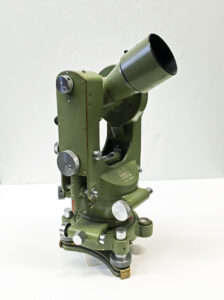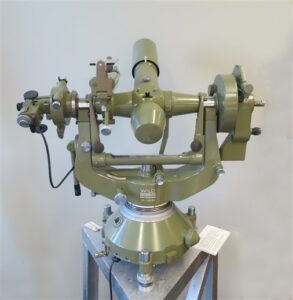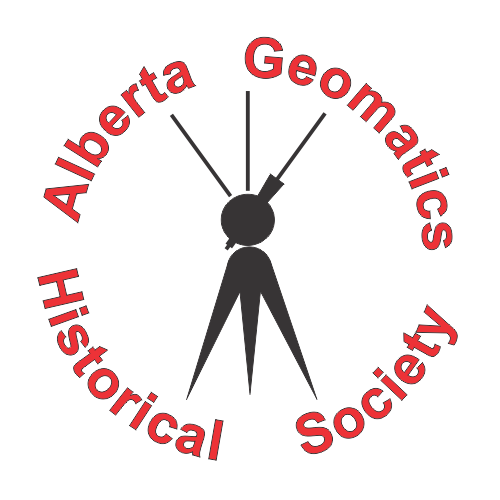
12. Wild – The Leader in Optical Theodolites
By Gordon Olsson
The story is that, in 1902, Heinrich Wild, a 24-year-old Swiss surveyor stood behind his theodolite on the summit of the 10,686-foot-high Dents-du-Midi, a prominent peak in the Bernese Alps. He had carried a 25-kilogram theodolite up the mountain and had spent about two to three hours adjusting his instrument before a storm forced him to abandon his work. This experience resulted in him designing a reliable, lightweight and less bulky instrument that could be ready for measuring immediately after it was set up. In 1908, Carl Zeiss, a company in Jena, Germany gave him the opportunity to head a branch of the company manufacturing instruments using his design. While there, he developed the Th1 Theodolite, a forerunner of later optical theodolites that he produced.
At the end of World War I, Heinrich Wild returned to Switzerland and in 1921 he, with two partners, founded the firm of Heinrich Wild. In 1924, after repeated delays due to technical problems and the inability to find trained precision mechanics and opticians, the Wild T2 was introduced to the market. It was the first optical theodolite that the firm produced, and it had a direct reading of 1”. Several other theodolites followed that were developed with Heinrich Wild’s expertise: in 1925 the T3, in 1933 the TO Compass Theodolite and in 1934 the T1.
Heinrich Wild’s optical theodolites revolutionized survey theodolite design. It had divided glass circles. Readings were taken from both sides of the circles and, using mirrors and prisms, they were presented at a single eyepiece. Because the eyepiece was placed next to the telescope of the theodolite, the observer only needed to move his head by a small amount to read the circles. This alleviated the need for the observer to move around the theodolite to read the circles using verniers located on the horizontal and vertical circles of the instrument. The Wild instruments were also smaller, easier to use and more accurate than the traditional theodolite and they were sealed from rain and dust.
In 1933, Heinrich Wild left the company and became a freelance designer and inventor. Wild continued to commission him until 1935, until he started working with the Swiss firm Kern & Company where he remained until his death in 1951. With Kern, he designed the DK2, DKM1, the DKM2 and DKM3 theodolites (See the next article).
In 1937, the Wild company was renamed Wild Heerbrugg. It continued producing theodolites as well as aerial cameras, stereoplotters and other optical instruments. In 1986, it merged with Leitz to form the Wild Leitz Group.

Wild T2 s/n 179046 – date of production of this theodolite was 1974. The Wild T2 has direct reading to 1”. Development of the T2 started in 1921 with the first ones produced in 1924. There were four models; the original T2, the NT2, the T21 and a T2 model that was produced from 1973 to 1996 when production was discontinued. It was ideally suited for almost every type of survey task including 2nd and 3rd order triangulation.
Reg Watson Estate
SHF 2015.01.03

Wild T1 Micrometer Theodolite s/n 266759 – date of production of this theodolite was 1981. Four models were produced; the original model first produced in 1933, the NT1, the T1A first produced in 1957 and the T1 Micrometer Theodolite produced from 1973 to 1996 when production was discontinued. It was a less precise instrument than the T2 with direct reading to 20”. The T1 was the first Wild theodolite to have an interchangeable tribrach which made it ideal for traversing and cadastral survey work.
Donated by Bruce Gudim, ALS (Hon. Life), Maltais Geomatics
ALSA 2009.07.01

Wild T1A s/n 126542 – date of production of this theodolite was 1969. The T1A was first produced in 1957. It had an automatic compensator for the vertical circle. Similar to the T1, it had direct reading to 20” and was idea for traversing and cadastral survey work.
Reg Watson Estate
SHF 2015.01.09

Wild T16 s/n 245388 – date of production of this theodolite is 1978. This model of the Wild T16 was produced from 1973 to 1995 and it replaced an older model T16 that dated back to 1956. The T16 featured easily read scales and optimum placement of clamps and tangent screws which made for easy operation. Similar to the Wild T1A, it was ideal for traversing and cadastral survey work.
Donated by Irwin Maltais, ALS (Ret.), Maltais Geomatics
ALSA 2009.08.01

Wild T3 s/n 91173 – date of production of this T3 is 1962. The T3 was produced between 1925 and 1988. It is similar to the T2 in operation, however with larger and more accurate circles. In the article “100 Years of Geodetic Surveys in Canada” it is stated:
“When the Wild T2 Universal Theodolite first appeared in 1924, its revolutionary design caught the attention of J.L. Rannie of the Geodetic Survey Division (GSD). The T2 was small and lightweight (5.6 kg) compared to the old large 300 mm theodolites which had to be packed in two huge boxes. While the precision of the T2’s angle-reading system was not a factor, its telescope aperture was too small for the long lines observed on geodetic triangulation. It was mainly as a result of suggestions by Rannie that Wild designed the T3 precision theodolite, a slightly larger theodolite (11.2kg) with a telescope of increased aperture. The T3 was adopted by GSD in 1927 as the workhorse for triangulation work and by 1929, twelve instruments were in use. The T3 continued to be employed by GSD into the late 1980s, specifically on high precision trilateration work.”
Donated by the Surveyor General Branch, Natural Resources, Canada
ALSA 2016.01.07

Wild T4 s/n 120745 – date of production of this T4 was 1965. The T4 was produced between 1941 and 1981. It is one of the largest and most precise micrometer theodolites ever made. It was used for first order geodetic triangulation and astronomical observations. It has 65x magnification. The horizontal circle is read directly to 0.1” and the vertical circle to 0.2”. It is about 45 centimeters high and weighs approximately 60 kg. The telescope assembly is removed for transportation. Between 1941 and 1981, only 439 T4s were produced.
Donated by the Surveyor General Branch, Natural Resources, Canada
ALSA 2016.01.01
Sources of Information:
- Online article: 100 Years of Geodetic Surveys in Canada, The Canadian Geodetic Survey.
- Virtual Archive of Wild Heerbrugg,
- 100 Years Innovation Heerbrugg, April 1921. https://wbk.wild-heerbrugg.com/en/home
- Wild Surveying: https://shop.wild-heerbrugg.com/index.php?cPath=1_3
- How old is my Wild Instrument? https://wbk.wild-heerbrugg.com/produkte/wie-alt-is-mein-wild-instrument.
- Website of Nicolas de Hilster, PhD, Geodetic Instruments: https://www.dehilster.info/geodetic_instruments/theodolites.php.
- UNSW Surveying Instrument Collection: https://vm.civeng.unsw.edu.au/surveying/f_pall/html/home_page.html.
Author: Gordon Olsson, ALS (Hon. Life)
January 19, 2022
Copyright 2024 © Alberta Geomatics Historical Society
